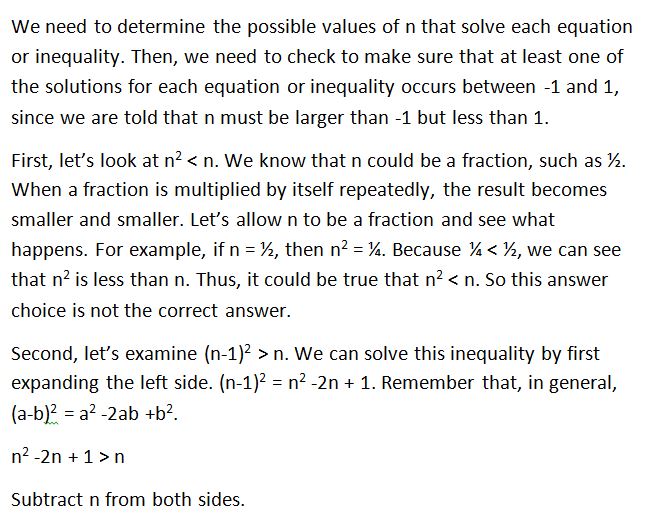How to find the solution to an inequality with multiplication - PSAT Math
Card 0 of 10
If –1 < n < 1, all of the following could be true EXCEPT:
If –1 < n < 1, all of the following could be true EXCEPT:
Compare your answer with the correct one above
(√(8) / -x ) < 2. Which of the following values could be x?
(√(8) / -x ) < 2. Which of the following values could be x?
The equation simplifies to x > -1.41. -1 is the answer.
The equation simplifies to x > -1.41. -1 is the answer.
Compare your answer with the correct one above
Solve for x

Solve for x
Compare your answer with the correct one above
Fill in the circle with either  ,
,  , or
, or  symbols:
symbols:
 for
for  .
.
Fill in the circle with either 





Let us simplify the second expression. We know that:

So we can cancel out as follows:


Let us simplify the second expression. We know that:
So we can cancel out as follows:
Compare your answer with the correct one above
We have  , find the solution set for this inequality.
, find the solution set for this inequality.
We have 
Compare your answer with the correct one above
Give the solution set of the inequality:

Give the solution set of the inequality:
Divide each of the three expressions by  , or, equivalently, multiply each by its reciprocal,
, or, equivalently, multiply each by its reciprocal,  :
:




or, in interval form,
![\left ( 5\frac{1}{3}, 9 \frac{1}{3} \right ]](https://vt-vtwa-assets.varsitytutors.com/vt-vtwa/uploads/formula_image/image/230643/gif.latex) .
.
Divide each of the three expressions by 

or, in interval form,
![\left ( 5\frac{1}{3}, 9 \frac{1}{3} \right ]](https://vt-vtwa-assets.varsitytutors.com/vt-vtwa/uploads/formula_image/image/230643/gif.latex)
Compare your answer with the correct one above
Give the solution set of the following inequality:

Give the solution set of the following inequality:





or, in interval notation,  .
.
or, in interval notation, 
Compare your answer with the correct one above
What is the greatest value of  that makes
that makes

a true statement?
What is the greatest value of 
a true statement?
Find the solution set of the three-part inequality as follows:





The greatest possible value of  is the upper bound of the solution set, which is 277.
is the upper bound of the solution set, which is 277.
Find the solution set of the three-part inequality as follows:
The greatest possible value of 
Compare your answer with the correct one above
What is the least value of  that makes
that makes

a true statement?
What is the least value of 
a true statement?
Find the solution set of the three-part inequality as follows:





The least possible value of  is the lower bound of the solution set, which is 139.
is the lower bound of the solution set, which is 139.
Find the solution set of the three-part inequality as follows:
The least possible value of 
Compare your answer with the correct one above
Which of the following numbers could be a solution to the inequality  ?
?
Which of the following numbers could be a solution to the inequality 
In order for a negative multiple to be greater than a number and a positive multiple to be less than that number, that number must be negative itself. -4 is the only negative number available, and thus the correct answer.
In order for a negative multiple to be greater than a number and a positive multiple to be less than that number, that number must be negative itself. -4 is the only negative number available, and thus the correct answer.
Compare your answer with the correct one above









